
OTTAWA — Researchers in Ontario believe expanding wastewater monitoring can be key in helping to detect and curb COVID-19 outbreaks because, simply put, not everyone gets tested but everyone poops.
To untrained eyes, our wastewater is a biohazardous slurry. But microbiology experts see so much more. And as it happens, tracking viral shedding of the novel SARS-CoV-2 virus in wastewater can be a useful source of additional data during a pandemic. “Shedding” is what happens when an active virus is released from an infected person’s body through coughing, sneezing, speaking moistly or trips to the toilet.
This spring, Ottawa became one of the first cities in North America to monitor COVID-19 levels in its wastewater. But monitoring shedding comes with some technical difficulties, especially in a municipal system where wastewater combines with stormwater in the same pipes. Researchers found help in the form of peppers — yes, the vegetable.
Because wastewater changes from location to location, researchers in the nation’s capital needed to find a reliable reference gene to act as a control. Industrial activity and stormwater can dilute concentrations of COVID-19 in samples, risking inaccurate low readings of the virus.
Researchers picked the pepper mild mottle virus (PMMoV) because it is ubiquitous in healthy human populations where diets include peppers and processed derivatives. Of course, what goes in eventually comes out, making the PPMoV the biomarker of choice. Plus, it’s seemingly unique to humans, rarely found in animal feces.
Watch: Chief public health officer says pandemic ‘fires are burning’ across most of Canada. Story continues below video.
Ottawa had its wastewater coronavirus monitoring system in place before the city’s low confirmed case count took a turn mid-summer. At the start of the pandemic, the city saw relatively low case counts. When summer arrived, the numbers really started to climb and the city became considered a “hot spot” for COVID-19 activity.
On July 18, Ottawa public health officials announced the city’s first double-digit increase in the number of new daily cases — a trend that hasn’t reversed. Public health officials blamed young people and the temptation of summer socializing and flouting physical distancing advice as factors behind the rise in numbers.
Researchers monitoring COVID-19 levels in the city’s wastewater saw the dramatic increase — in real time — days before human testing results confirmed the city was “strapped to a rocket.”
“We saw a spike, approximately a tenfold increase in our wastewater value, two to three days before,” said Robert Delatolla, associate professor at the University of Ottawa’s department of civil engineering specializing in the study of microbiology of wastewater.
When the number of daily confirmed cases dramatically increased in late September, showing the start of a second wave, the pattern was reflected in the city’s wastewater COVID-19 viral signal readings.
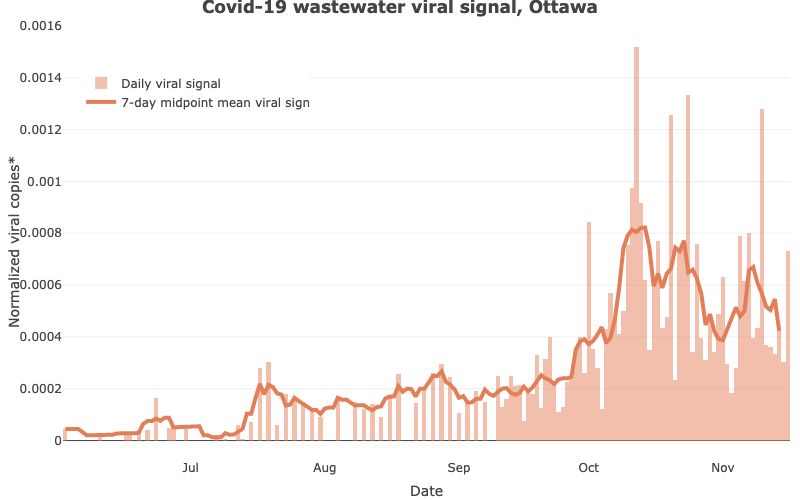
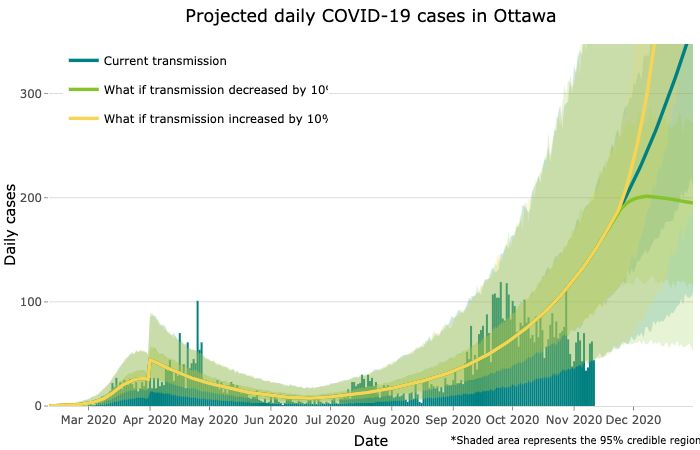
The benefit of wastewater readings is that public health officials get a little bit of a heads-up before human testing numbers follow days later. After the July spike, officials asked Delatolla’s lab to increase its sample collection, which had been every second day, to daily tests. “That really motivated us to move,” he said.
Monitoring COVID-19 in wastewater is novel as much as it is practical.
Testing humans for the disease, in comparison, is one way to track the spread of COVID-19 but results are highly variable. It’s dependent on a number of factors including the supply of testing kits, turnout, and lab resources. In Ottawa, the number of people who lined up to get tested at the end of summer as schools reopened overwhelmed the public health system. People waited for hours in line to get tested. Then it took anywhere from three days to more than a week for test results to come back negative or positive.
Another cruel reality of the coronavirus that’s fuelling the pandemic is that it spreads through both symptomatic and asymptomatic transmission, it just isn’t possible to count and report every positive case. Not everyone gets tested.
Wastewater testing not affected by changes in public interest
Dr. Monir Taha, associate medical officer of health with Ottawa Public Health said what’s attractive about COVID-19 testing in wastewater is its “almost universal compliance.”
Everyone who flushes a toilet is a contributor and participant, he told HuffPost Canada, and the study design “does not require any additional effort or demands on people’s time, nor uncomfortable swab testing.”
Turnaround time is another allure. A polymerase chain reaction (PCR) test is a type of diagnostic test considered to be the gold standard used to detect mere traces of the virus’ genetic code to determine if someone has COVID-19. PCR tests provide an exact read at the molecular level. But it’s costly and requires lab equipment, also time. Processing nasopharyngeal swab tests can sometimes take days for labs to turn around results — longer if lab capacity is stretched thin.
Wastewater samples, in comparison, can be drawn in the early morning, go through a PCR test, and be processed by late afternoon.
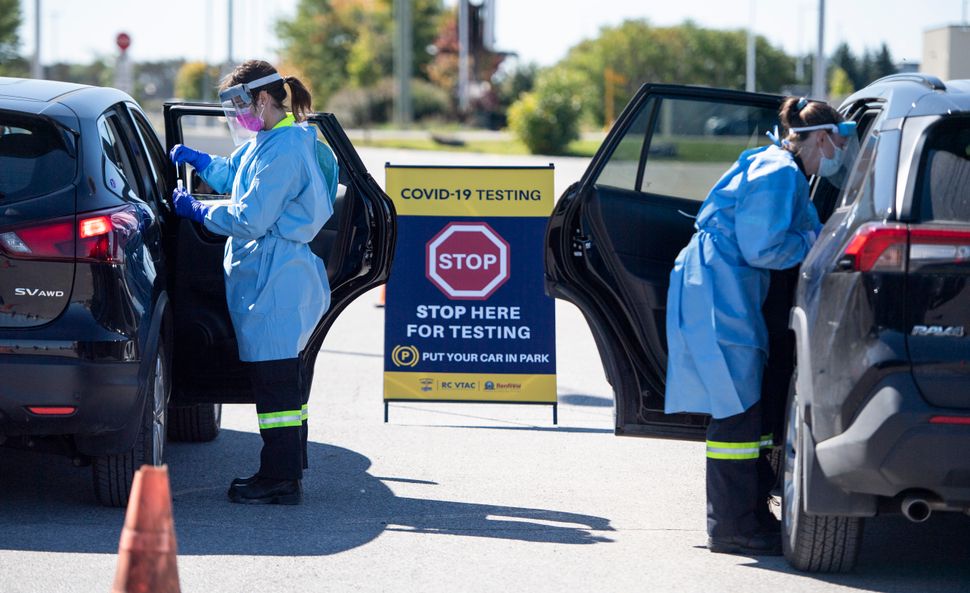
“Wastewater testing results are a way to triangulate what we are seeing from human testing, because it will not be affected by variables that affect human testing rates, such as swab shortages, testing lineups, or increased or decreased public interest,” Taha said.
The extra layer of data from wastewater helps with modelling, which is invaluable for public health officials trying to manage outbreaks without overwhelming the health care system.
Rapid testing is another diagnostic test that has repeatedly come up in the House of Commons. It’s an inexpensive alternative that promises on-the-spot results to a public wearied with “COVID fatigue,” eager to enjoy simple pleasures in life without considering menacing scenarios of being a potential conduit in a deadly chain of transmission.
The technology recently sparked a lively debate after the Conservative health critic accused the prime minister of “blocking” approval of at-home rapid COVID-19 test.
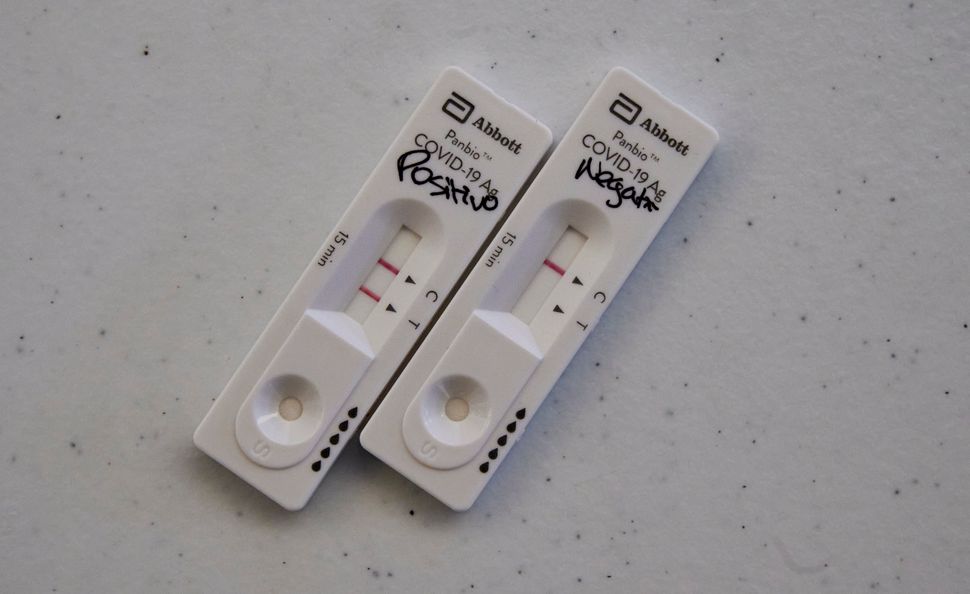
The Panbio test, developed by Chicago-based Abbott Laboratories, was approved in the U.S. in September and Health Canada followed with its own green light in October. The technology is different from a PCR test.
Rapid tests are considered less accurate because they read antigens, which are proteins on the surface of SARS-CoV-2 particles. And they only work best if a sample contains a high viral load or if an infected person is at their most contagious — which is why sometimes antigen tests yield false positives.
The reason for this is because at-home tests are also dependent on a person’s dexterity with a nasopharyngeal swab.
For anyone who has had the distinct experience of craning their head back and having a health care worker in head-to-toe personal protective equipment push a nasopharyngeal swab so far back into your nasal passageway your eyes begin to water; at-home tests require users to do that twice — once in each nostril. And that’s before diluting the sample in a squeezable test tube to pinch five drops onto a portable credit-card size test with specially coated strips to detect COVID-19.
The federal government has signalled plans to buy 20 million Panbio tests. Canada’s deputy chief public health officer has suggested any positive rapid tests results be followed up with a PCR test.
Public health officials alarmed over explosion of cases
Canadians, long warned about a second wave of COVID-19 cases in the fall, are seeing spikes in cases across the country in recent weeks. Ontario and Quebec hit grim milestones in October with daily case counts now regularly exceeding 1,000. Nearly three-quarters of Canada’s cases are in those two provinces alone.
Sharp explosions in confirmed cases in Manitoba, Saskatchewan, and Alberta have a new region of the country on high alert, with political officials setting expectations that stronger restrictions may have to be taken if numbers fail to fall significantly.
Public health officials across the country are alarmed at how fast cases are rising heading into the winter.
The first Canadian case was reported on Jan. 25 in Toronto. It took nearly six months to reach the 100,000th confirmed case in mid-June after an initial spring lockdown. Canada doubled its number of confirmed COVID-19 cases to reach the 200,000 threshold on Oct. 19, climbing another six-figures less than a month later.
As of Nov. 16, Canada passed a grim milestone with more than 300,000 reported cases of COVID-19 in the country. According to recent modelling data, the current daily case count has surpassed the peak rate recorded during the first wave.
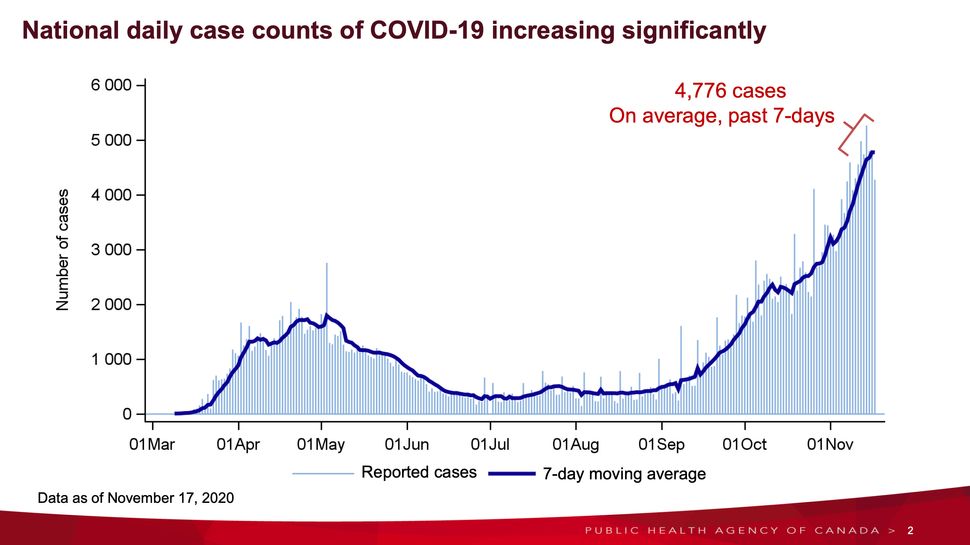
Chief Public Health Officer Dr. Theresa Tam warned Canadians on Friday that if the current growth holds, Canada is on path to witnessing 20,000 daily new cases by the end of December. Worst case scenario, if people slack on dramatically reducing their social activity over the next month, the figure could increase to an alarming 60,000 new cases daily.
* * *
Testing wastewater for levels of infectious disease isn’t a new idea. Before the pandemic, University of Hawaii researchers showed that salmonella concentrations found in municipal wastewater correlated with the number of reported clinical cases. The tests even found rare strains of the bacterial disease “missed by clinical efforts.”
Similar projects have been launched in the Netherlands, Australia, Finland, and Germany. Successful results in those countries have led to new national surveillance programs to complement other public health initiatives such as human testing.
More attention was drawn to its potential COVID-19 application after the University of Arizona launched a small-scale project to control outbreaks when 5,000 students returned to campus at summer’s end.
To prevent large, school-wide uncontrollable chains of transmission, the university tested for COVID-19 in wastewater samples from each dorm. This was done to quickly identify hot spots where symptomatic and asymptomatic students lived. Positive tests would enact protocols that included isolation and extra resources allotted to specific dorm locations to stop the infectious disease from spreading further.
“Another thing we’re looking at is going right up to long-term-care facilities and going [into the sewer] right in front of the care facility.”
- Robert Delatolla, University of Ottawa civil engineering associate professor
Daily tests in multiple locations is what Delatolla envisages as the next iteration of wastewater testing in Ottawa and in other “red alert” areas — the label a region gets when it’s one surge of cases away from a lockdown.
The goal of the next iteration of the project is to chop the region into sections, Delatolla said, to get samples directly from neighbourhood sewers to improve accuracy in identifying specific areas where COVID-19 cases are surging. A more targeted approach for more detailed community data.
“Another thing we’re looking at is going right up to long-term-care facilities and going [into the sewer] right in front of the care facility,” Delatolla said.
* * *
In Ottawa, all wastewater that enters the sewage system ends up at the Robert O. Pickard Environmental Centre, a treatment facility about 15 minutes east of Parliament Hill. That’s the spot where researchers have been collecting their daily samples of wastewater.
There’s a very specific location inside the facility, underground and down a long concrete hall and stairs, where samples are taken: from a valve after wastewater passes through coarse and fine filters. This is where the “primary clarified sludge” is collected for COVID-19 testing.
Samples are picked up at 7 a.m. every day and placed in a cooler to keep the temperature stable about four degrees Celsius. The sample is transported to a lab for processing and tests, with results available about 5 p.m.
The wastewater treatment facility is the only one that serves the nation’s capital. Another one across the river, on the Quebec side, services the neighbouring municipality in Gatineau. The samples Delatolla’s team has been collecting reflect an entire region of eastern Ontario.
“Right now we see with our one sample, we take the sample of 910,000 people at once,” he said.
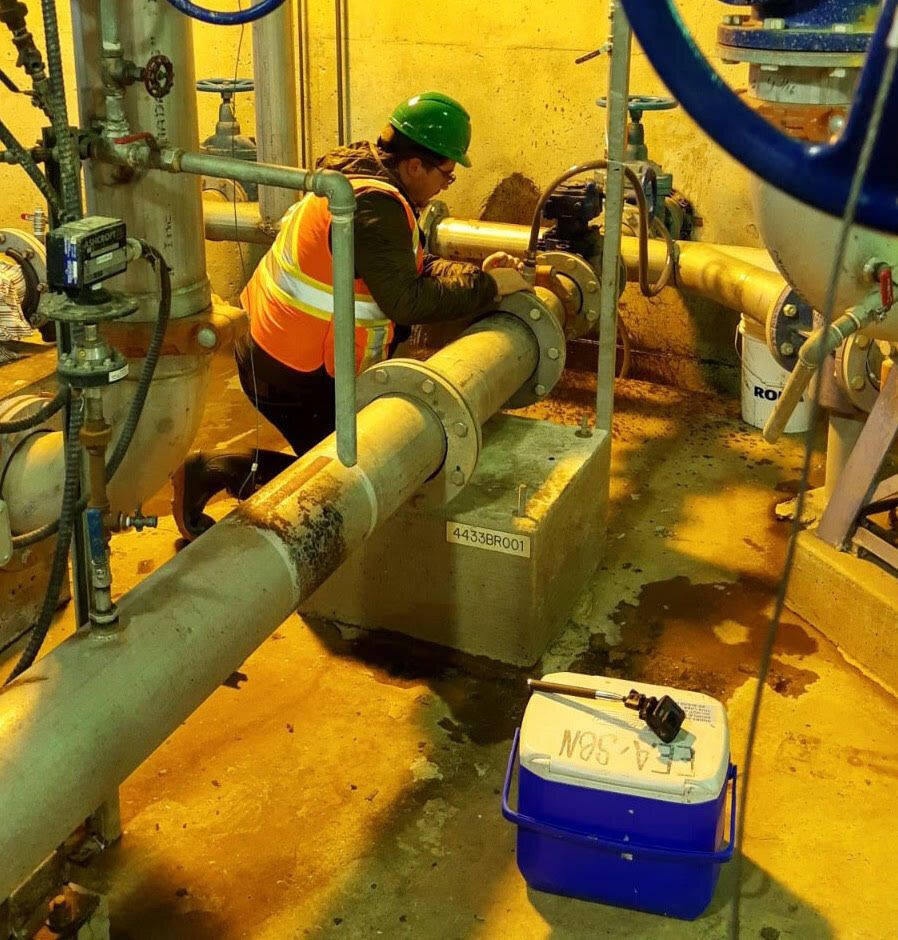
Delatolla said his microbiology lab found itself in the right place at the right time (and with the right equipment) to launch a project to monitor COVID-19 levels in wastewater.
His team partnered with a lab at the Children’s Hospital of Eastern Ontario. And unique to the unprecedented times, researchers from different projects shuttered because of the pandemic reached out to help. It took his team about two months to get their workflow down.
They had their system in place throughout June when the case count was low before cases rose on July 19. As news headlines reported on local shortages of tests, overwhelmed labs, and long waiting times for tests, Ottawa researchers put their wastewater data online, translated the data into graphs and made the information publicly available.
When they started their research in April, the impact of COVID-19 at the end of that month left 1,178 people with confirmed cases, leading to 73 deaths. By Nov. 16, the numbers in the city had climbed to 7,957 confirmed cases and 359 deaths. Wastewater readings have shown similar trendlines to human testing. Its efficacy has caught the interest of the Ontario government as well.
Delatolla’s team published their findings in October. Shortly after, the province announced in its budget that $12 million will be set aside over the next two years to fund a pilot project that “could provide an early warning of COVID-19 outbreaks.”
Despite optimism about two vaccine trials, the number of confirmed cases reasserts the fact that Canada is firmly in a second wave. Mass distribution of an eventual vaccine is still at least several months away.

Patrick D’Aoust, a Ph.D candidate at University of Ottawa’s department of engineering involved with the project, told HuffPost that it costs approximately $500 to process each wastewater test. That price multiplied by the number of new daily testing sites can quickly exhaust funding, particularly during a pandemic where multiple regions have been hit hard by the virus.
“In an ideal monitoring world, we would do two to three samples a week per [long-term-care home], which would amount to 4,000-6,000 a month, per facility. You can scale this up to get an idea of the cost,” D’Aoust said.
“There’s evidently a point where we would run out of capacity in the lab and would require additional capital cost funding to expand too.”
COVID-19 has had a disproportionate impact on Canada’s seniors. As of Nov. 18, nearly 97 per cent of the 11,000 coronavirus-related deaths reported across the country were people over the age of 60, many of whom lived in long-term-care homes.
According to the Ontario Long Term Care Association, there were 626 long-term-care homes licensed to operate in Ontario as of February 2019.
Following Ottawa’s lead, other municipalities including Toronto and Durham region in Ontario have also started testing levels in their sewersheds to predict the pace of their pandemic waves. The hope is the same: to catch an outbreak early — or no sign of COVID-19 at all.
One day.